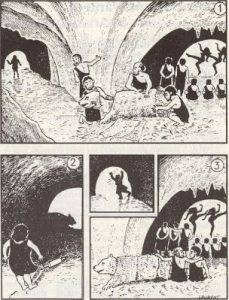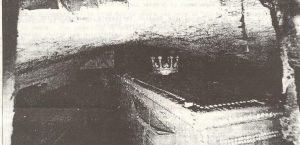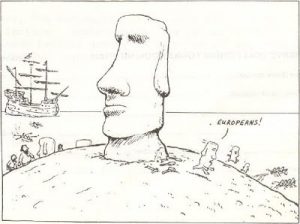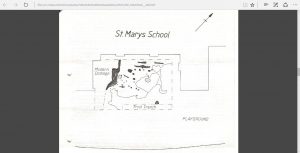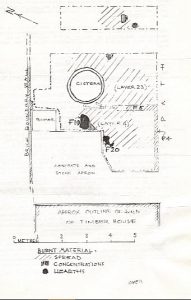NEWSLETTER 254 MAY 1992 Edited by Andy Simpson
DIARY
Tuesday May 5th: HADAS Annual General Meeting. To be followed by slides of HADAS excavations and fieldwork 1991-2. Do attend this important event and catch up on recent events and progress.
Saturday May 16th: Outing to Sutton House, Hackney and Waltham Abbey (Details and application form enclosed with this newsletter). You’ve heard the lecture, now see the house:
Saturday June 20th: Outing to Loughborough, Rushton and Geddington.
Saturday July 11th: Outing to Witney.
Saturday July 25th: Visit to Bentley Priory. See note by Bill Firth in this Newsletter (see page 4).
Friday, Saturday, Sunday August 21-22-23: Weekend in Dorset.
Saturday September 26th: A Walk in Southwark, with Mary O’Connell
Saturday October 10th: M I N I M A R T
REMEMBERING THE BATTLE OF BARNET
On Easter Monday, 20th April, several HADAS members enjoyed the sight of a dozen or so members of the White Company, in full armour in some cases, march briskly from Barnet centre to Hadley Highstone, where a wreath was laid. The menfolk were accompanied by several of their ladies acting the part of camp followers: it is hoped that up to 200 members of the Company will be involved in a re-enactment of the battle next year. The standard of the reproduction clothing and armour was most impressive, covering the range from impoverished and ill-equipped Billman to plate-and-mail-equipped professional.
“GRAPHIC NOUVELLE at Church Farm Museum. Dubious about Judge Dredd? Wary of the “Watchman”? Puzzled by pizza-eating turtles? Then go to the exciting new exhibition at Church Farm Museum that chronicles the growth of cartoon-strip characters and “visual storytelling”. Running to 31st May. Admission charge (E1.00) Saturdays only. Free other. days.
IT’S NICE TO BE APPRECIATED:
The “Society News’ column of the March 1992 issue of the CBA’s “British Archaeological News” carried the kind comment that “The Newsletter of the Hendon & District Archaeological Society is often full of incident, the February 1992 issue being no exception with its report on recent observations at Stanmore Church:”
“A” LEVEL ARCHAEOLOGY COURSE: this largely postal course, which can be followed without necessarily taking the exam at the end, covers a range of archaeological issues. Details from Sam Garin, Newarke Sherwood College, Friary Road, Newark, Notts. NG24 1PB.
OLD FOLD MANOR, BARNET BRIAN WRIGLEY
In December 1991, the Museum of London carried out an archaeological evaluation at the Old Fold Manor Golf Club, Barnet – a site where interest centres on the remains of a moat. A copy of the evaluation report which the Museum kindly supplied, is now
in HADAS library available to Members. The report includes a couple of pages of historical background, largely on the Battle of Barnet. The site location plan reproduced here shows the area. The excavation was confined to 3 test pits within the moat (an area proposed as a car park) and a 20m X 4m trench outside the moat to the North, where a new building is proposed. The 3 test pits were taken down only to the archaeological layers, a maximum of half a metre below the present surface, and recommendations are made for the protection of these layers when the car-park is surfaced. In the trench outside the moat, various dumped layers were found, including a possible ditch or foundation trench suggesting occupation at some period. Apparently no dateable features were found; again, recommendations are made to minimise disturbance to the stratigraphy in using piles for the new building.
(SEE ALSO NOTE BY BILL BASS – ED.)
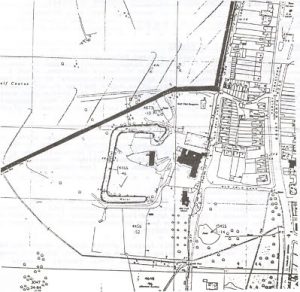
A LOAD OF OLD COBBLERS GRAHAM A. JAVES, MA
Recent renewed interest in the Barnet medieval shoe in Barnet Museum led to the visit in January of June Swann, consultant in the History of Shoes and Shoemaking and to a reassessment of the shoe. Miss Swann considers it to be the remains of a man’s right foot ankle boot (1350 1360) though the upper part, above the ankle is missing. Detailed notes are available at Barnet Museum.
During her reappraisal, Miss Swann examined the pile of leather, which in living memory, has been displayed with the boot. This proved a revelation. Firstly, she found the insole of the medieval boot in three pieces which fit together like a jigsaw.
Then there is a fragment of a leather garment, possibly from a jerkin 16th century, possibly Elizabethan. It has two rows of design, visible when viewed with an oblique light. Its irregular shape includes one whip-stitched edge, and an overlapped seam.
Thirdly, Miss Swann discovered two pieces of leather sole from a Roman woman’s or teenager’s sandal. That’s right, a Roman find in Barnet and at the Museum. These date from circa 2nd to early 3rd century AD. One piece has wear at the heel. It may be an integral layer near the sole, or the sole for the left foot. If the latter, it does not belong with the other piece. It may be a clump repair. It has hobnail impressions – Roman women did wear hobnails. The other piece is definitely a right foot insole. It has outlining for the toes and two holes for the V-straps which went between the first and second toes to hold it on. Parallel slots round the edge are for thongs to hold layers of soles together.
After that discovery, the last find pales into insignificance. It is a piece of heavy leather, probably the outside counter, from a man’s right boot (17th to mid-18th century).
Now the anticlimax the provenance of these objects found Barnet Museum, 1992: The ankle boot was found in 1956, at a depth of 4.5 to 5 feet, by workmen laying a new storm water sewer in the Bottleneck in the High Street beside Barnet Church. The find was recorded in the Museum acquisition book and published in the “Barnet Press”. Clearly, the insole to the boot was also found there, but where did the rest come from?
In the absence of further evidence, it is far from certain that the Roman, 16th and 17th/18th century objects all came from the Bottleneck. As well as a sewer, new concrete foundations were laid. This presumably involved excavating the full width of the road to a depth of at least five feet: a very big hole: Work lasted some ten weeks, during which time traffic was diverted around the town centre. A horseshoe, thought to be 16th century, and some animal bones were found, but no other leather finds were recorded, nor apparently was any pottery found.
It is particularly galling that the Roman objects must remain of very doubtful provenance to tease us, like the story of the “Roman” bricks said to have been found at the turn of the century on the Old Cottage Hospital site at the corner of Barnet High Street and the Meadway. Personally, I am inclined to the opinion that these objects came from elsewhere and that this little collection of leather fragments, representing a remarkable variety of periods, came together in Barnet Museum.
There is, of course, a moral to this story for both curators and archaeologists leave good records for those coming after you. June Swann, MBE, BA, EMA, was formerly Keeper of Shoes at Northampton Museum. Her published work includes “Shoemaking” (Shire Album 155, 1986) and “Recent research in Archaeological Footwear” edited jointly with
D.E. Friendship-Taylor and S. Thomas (Association of Archaeological Illustrators & Surveyors in association with the Archaeological Leather Group, 1987) 49pp.
(It is a great shame that the Roman material is of doubtful provenance. The HADAS excavation of the nearby “Mitre” car park in 1989/1990 unearthed a single sherd of Roman pottery – an interesting coincidence, at least: Ed)
25 JULY 1992 – VISIT TO BENTLEY PRIORY
By kind permission of the President of the Mess Committee, Wing Commander G.S.F. Booker RAF, an afternoon visit has been arranged to Bentley Priory which, from July 1936 until April 1968 was the Headquarters of Fighter Command and which is still the RAF Officers’ Mess. Applications for a limited number of places together with a sae for return of joining instructions to:
BILL FIRTH, 49 Woodstock Avenue, London NV11 9RG
PLEASE NOTE: RAF security is stricter than it was and drivers coming by car must let me know the make, model, colour and registration of their vehicle together with the names of their passengers. If you are coming by public transport please let me know so that I am in no doubt about who is arriving by car. The RAF is very insistent that these details are supplied and I will not give the names of anyone who does not send them to me.Bill Firth
EDGWAREBURY PARK BILL BASS
During February/March 1992 the London Borough of Barnet commissioned the Museum of London Archaeological Service (MOLAS) to make an archaeological and landscape assessment of Edgwarebury Park’s north section as this area is to be replanted as part of the Community Forest Programme. This area (TQ 1895 9360) covers 2-5 hectares and is situated on the junction of Edgware Way (A41) and Edgwarebury Lane. It lies approximately 1 Km east of Brockley Hill with associated Roman kilns on Watling Street. Other evidence in the general area includes prehistoric, Saxon and medieval. Some of the field boundaries are at least 400 years old as shown on a map of 1599 and can still be traced on modern maps.
HADAS were asked to conduct a sample resistivity survey to try and locate any possible buried features. The surface here seems to have escaped ploughing or other serious disturbance and at present consists of scrubland which borders Edgwarebury Farm to the North and hest, and according to some air photos may have contained ridge-and-furrow,
although no sign of this as yet can be found at ground level. Underlying geology is London clay with a surface of top/plough soil as observed when a trench was cut 2-5m deep for the Three Rivers Pipeline which ran across Edgwarebury Farm in 1989 (HADAS Newsletter 241).
At the beginning of March, the official HADAS survey team made a series of 5 resistivity runs north-south of the site, 3 of approx. 50m in length one of 75m, and one of 100m. Results of this limited survey were inconclusive; variations recorded existing field drains. Other anomalies are difficult to interpret – these areas may be observed under site-watching conditions. The informative assessment by MOLAS will be lodged in HADAS library.
“Aeges Weir” (from the MOLAS report). While fieldwalking for the above project, an opportunity was taken to look at some earthworks which may form the basis of a further HADAS research and survey site: ie the remains of a dam are present on the stream just west of Edgwarebury Park. This stream makes a sharp kink around a series of earthworks that may well represent the site of a former mill. The map of 1599 also shows the fields upstream of the dam position, on either side of the stream as having once contained millponds. It has been suggested that this may be the Saxon origin of Edgware in “Aege’s Weir” but there is no proof, or may be the site of a medieval fish-breeding complex.
(Extract from MOLAS Report, 1992).
Old Fold Moat, Hadley. Work on demolition and rebuilding of the green-keeper’s store and pro golf shop in and around the moat (see report elsewhere) lasting several months started in April. Plans are being made to site watch and record anything of interest that emerges which is most likely to be with initial stripping (John Heathfield reports that metal detectors will be used in the hope of finding relics of the Battle of Barnet. – Ed.)
19-25 High Street, Barnet. Guyscliffe House and shops adjacent to Fitzjohn Avenue are no more, they currently form a neat pile of rubble under which HADAS would like to conduct a small rescue dig, extending an area last examined in 1990 producing medieval pottery. (Enquiries are being made into the possibility of excavating the shops site. – Ed.)
Church House, Wood Street, Barnet. This site is to become a doctor’s surgery with adjoining offices. Being a listed building in a conservation area, archaeological researches will have to be carried out and may be useful in the continuing hunt for Barnet’s medieval and later occupation. The nearby St John the Baptist Church was first built over 750 years ago and was rebuilt in 1420.
LIBRARY NEWS ROY WALKER
It is pleasing to report that the HADAS library at Avenue House is growing by the week thanks to generous donations from members. This month, Miss A H Ningo has kindly given the Society several books including many by Leonard Cottrell. The niece of Elizabeth Mason thought of HADAS when clearing her late aunt’s effects. Miss Mason’s books have filled some of the gaps left by the fire and included volumes of the series “Ancient Peoples and Places”. Last month’s Newsletter accredited the donation of this series to Barnet Library, however some of the titles listed were from Margaret Maher to whom our thanks are given. Thanks are also given to Mrs. D Rookledge, Miss M Large and Andy Simpson for their much appreciated contributions received since Vikki and I took over the Library. Finally, many thanks to Arthur Till who is set to spend his retirement making more bookcases for Avenue House if the collection continues to expand at the current rate.
Editor’s Note – Glad my contributions were of use
Activity at the Garden Room, Avenue House is quite intensive at present with work also under way on the report of the Forge Site, Golders Green excavation last autumn. The Borough of Barnet have also asked us to produce a plot of all archaeological finds and areas of archaeological importance in the Borough; a first draft has now been completed. Members of the excavation team are present most Sundays – visitors welcome, but ring one of us first in case we are out on site.
LAMAS CONFERENCE, MARCH 1992
The Annual Conference of London Archaeologists held at the Museum of London last March was a day of glimpses into other people’s archaeology. We were able to view examples of work by other local groups and in return offer a photographic record of recent excavations and projects undertaken by HADAS. Seven copies of the West Heath Report and other Society publications to the value of £90 were sold and a valued contact made with a
member of the Pinner Local History Society with an interest in timber-framed buildings who has kindly inspected the Whetstone House and added to our survey.
The morning session provided glimpses into five excavations on sites in central and outer London covering all periods from prehistoric to medieval. The lecturers, all but one from the newly-created Museum of London Archaeology Service, MOLAS, – no more DUA and DGLA – detailed the problems, the initial results and the main finds. A speaker from the Passmore Edwards Museum outlined a rescue dig on the Essex gravels identified from crop-marks as a series of enclosures. Due to lack of funding, this late Bronze Age to Roman site with a 4th century AD kiln and timber-lined well had not been fully excavated. However, due to the building recession gravel extraction had been postponed … it’s an ill winds
Two Iron Age sites at Old Malden were reviewed in the light of other excavations in the Hogsmill Valley to compare settlement patterns and usage with the conclusion that one site was defensive and the other purely a non-defended settlement. Another riverside site, this one on the Thames at Bull Wharf in the City of London, had an unusual but macabre find – a bark burial. In post-Roman silts a skeleton was uncovered which had been left on the foreshore between high-and low-water levels with a moss cover. It lay on reeds and bark, similar to a burial found only once before, in Denmark. A later gravel embankment with a number of stakeholes gave evidence of a probable Saxon beach market.
(The burial was of a woman, aged 20-40, killed by a blow to the skull. – Ed.)
Gordon Malcolm, who recently supervised the excavation at St Mary’s School, Finchley, reported on a mid-Saxon site at Long Acre, Covent Garden. His findings were of a burial area (possibly a family plot but not a cemetery) later sealed by settlement from an expanding Saxon London with a trade zoning taking over from residential use. The evidence for trade came from a number of hearths with reused Roman tiles and associated slag with crucible fragments.
The afternoon session allowed us a glimpse behind the scenes of the environmental department of the museum, now called the Special Services Unit of MOLAS. The specialisations covered were archaeobotany, formal remains, dendrochronology and human skeletal remains. The environmentalists illustrated the use of scientific examination as a guide to archaeological interpretation and as an independant source of historical data. It was shown that even a key dating-tool, dendrochronology, has not been without its problems. Reused timbers provide a date of original use and imports from the Baltic in the medieval period caused mismatches with the museum chronology. To overcome these problems investigation has been made into changes in timber supply and a Baltic chronology is in course of preparation to join the London oak and beech ones. Dating, we were told, could also be deduced from wild mammal and bird remains. Fallow deer in Britain dates from the Iron Age or Roman period and the rabbit was a Norman import. The natural history of the animal when applied to the human environment can indicate hygiene standards, social status, wealth and dietary and ethnic preferences. Trade networks can be traced from exotic imports and local crafts and industries would have left butchery or skinning marks on bone.
The archaeologists have their own chronology based upon preserved plant and foodstuff remains. Certain environments favour the preservation of one type of remains; for instance waterlogged sites suit seeds and plants, cess preserves foodstuffs by mineralisation from body-secreted acids and grain is preserved by charring. A progression of food sources from Roman to post-medieval has been compiled although there is a bias in the nature of the finds – few waterlogged Saxon sites in London, mainly cess-pits for Roman finds, both favour only one type of find.
However, the history shows the use of grains for breadmaking by the Romans and Saxon with a reduction of grain finds in the medieval indicating the use of flour for domestic purposes, the grain being milled elsewhere. Roman imports of dill, fennel, grape and fig were reintroduced in the medieval and dumps of this period show an increase in cornfield and wasteland flowers and a greater use of straw (for bedding?). Archaeobotany has been able to indicate such diverse items as changes in diet, trade routes and the national economy.
The excavations at the Royal Mint Site since 1972 had produced 1200 burials, 80% of which were removed for examination and analysis by age, sex and pathology. The main burials were Black Death victims of 1350 and contained a high number of infants and juveniles. Height had been regarded as a sign of nutritional standards, but the famines of the 14th century were not reflected in a comparison of height and year of birth although those burials removed from the Church of St Mary Graces once on the site were taller than those buried outside. An analysis of disease by type had main groups of degeneration 45%, dental 30% and trauma 10%. One was the victim of beheading. Broken bones had been competently set with no sign of shortening. Arthritis, as to be expected, was more prevalent with age but more common in the male unlike the situation today. The areas afflicted were predominantly the shoulder, spine and hand.
Currently there are over 4,000 skeletons from various sites from the Roman period onwards awaiting research. It will be possible to use tests for blood protein, DNA and for the presence of antibodies to trace diseases and continue to provide us with more glimpses of our past.
(This was an excellent conference, with fewer displays, but more delegates, than the past couple of years – Ed.)
ARCHAEOLOGY AND THE HISTORY OF SUTTON HOUSE HADAS Lecture, Tuesday 7th April 1992
A large and appreciative HADAS audience enjoyed Mike Gray’s well-illustrated talk, no doubt inspiring many of us to follow up with a visit on May 16thl As a derelict and vandalised shell has been given new life by careful restoration, excavations and careful analysis of the building fabric has revealed many clues as to lost fittings and floor/staircase arrangements. Fascinating wall paintings have been revealed. Study of documents and contemporary paintings tells us something of former occupants such as Sir Rafe Sadleir, who served both Henry VIII and Elizabeth T. Ed.
STOP PRESS
HADAS Micromart last Saturday, April 25th, attracted quite a crowd—a bit of a crush the first hour as we were only using the ground floor of Church House. We disposed of quite a bit of summer wear and bulky bric-a-brac, and exceeded expectations by taking about £250. Hall and advertising expenses have to be deducted.
Many thanks to our usual stalwart helpers, Tessa provided home-made biscuits and cakes to
have with coffee, and John Enderby and Mary Rawtzen did the usual heaving back and forth. I was a bit under the weather but everyone had happy smiling faces and that soon cheered me up. Dorothy.
CAHOKIA MOUNDS, ILLINOIS—A WORLD HERITAGE SITE
by Stewart J. Wild
The mid-Western state of Illinois is not the sort of place you’d expect to find a United Nations World Heritage Site, but on a recent visit I was surprised to find an archaeological site on the banks of the Mississippi with just that designation.
The prehistoric city is referred to as Cahokia, although the original name is unknown. It is named after a sub-tribe of the Mini Indians who arrived here much later, shortly before the French in the 1670’s. Cahokia is sometimes referred to as ‘City of the Sun’, the name deriving from the sun symbolism on certain artifacts, and the belief that the inhabitants worshipped the sun as a deity or spirit.
The Indians of the late Woodland Culture inhabited the area for 150 to 200 years, beginning around 700 AD. A second, more sophisticated race—the Mississippian Culture—developed between 850 and 900 AD.
The Mississippians built over 120 earth mounds in the area, some for burials, others for ceremonial activities. Although many have been destr Dyed by modern housing and urban development, 65 mounds have been preserved within the boundaries of the historic site.
Monks Mound is the largest prehistoric earth construction in America. Covering more than 15 acres, this 100 ft. high four-tiered platform was built in four stages over a period of 300 years.
At its height. Cahokia’s 2,200-acre site had around 20,000 inhabitants. Four sun calendars, dating from around 1,000 AD, display the sophistication of Mississippian science and engineering. Called ‘Woodhenge` because of their functional similarity to Stonehenge, they marked the different seasons of the year by the alignment of perimeter posts at sunrise.
By 1,500 AD Cahokia was abandoned, perhaps because natural resources were depleted. A climate change in the 13th century may have affected their food supply, war, disease or social unrest could have played a role. What became of the Mississippians remains one of Amercia’s enduring mysteries.

